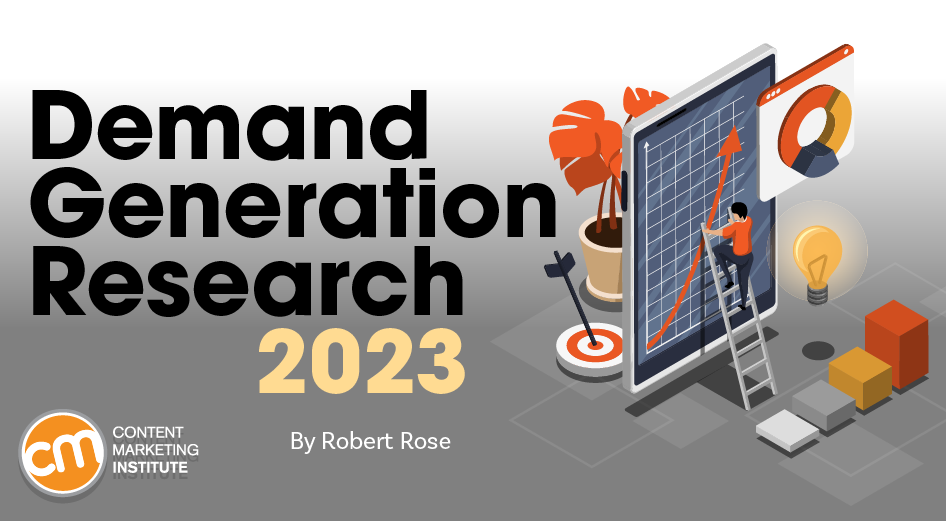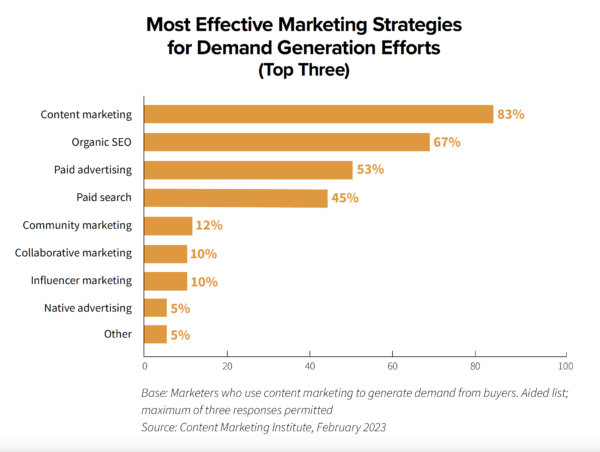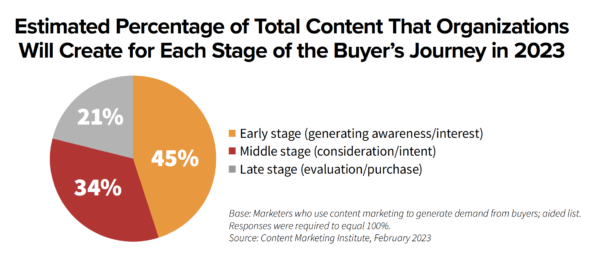B2B marketing teams face an increasingly complex challenge. When asking for more money and resources for activities that generate demand, they often hear, “We don’t have the budget for that.”
Instead, teams get plenty of resources and budget to nurture leads, get them to salespeople, and develop content that speaks to solving X, Y, or Z challenges. But they don’t get resources to create content and programs to generate awareness and demand for what solving X, Y, or Z means.
Lead-generation activities don’t generate actual demand. They’re mid-funnel programs that identify demand by promoting content to buyers already searching for solutions. Their goal is to attract prospects who realize they need a change but have yet to determine the best option. In a word that might sound familiar, these programs try to nurture the buyer’s decision in their favor.
Demand generation happens when prospects don’t realize they have a need or want. Marketing’s goal is to convince them they should embark on a buyer’s journey. In a successful demand generation program, marketers create demand where little or none exists. It’s a necessary pre-step before buyers enter your brand’s sphere of influence.
Demand generation happens when marketers help prospects realize a need or want they didn’t know they had, says @Robert_Rose via @CMIContent. #Research Click To TweetGreat content marketing helps generate demand, contributing to more effective demand identification and nurturing programs. Most content marketers understand this principle – it’s why they focus on creating content to inspire and teach people why they want to be customers.
New research brings disappointing findings
But our latest research suggests they don’t get the resources they need to focus on top-of-funnel content that generates demand, or they are asked (or choose) to focus on the middle of the funnel.
The newly released report, The Struggle To Generate Demand From Buyers, sponsored by DemandJump, illustrates that marketers in 2023 need more confidence in using content marketing for true demand generation.
This year, marketers shifted their efforts to pipeline growth and lead management. Simultaneously, the number of marketers who feel successful with demand gen dropped.
More marketers shift their efforts away from demand gen to focus on pipeline growth and lead management, says @Robert_Rose via @CMIContent. #Research Click To TweetIn contrast, last year’s demand generation study noted a “return to some of the demand generation priorities we’ve seen in the past” — top-of-the-funnel brand awareness and actual demand generation were priorities.
Still, content marketing continues to be a significant driver in demand generation. When asked, most marketers (83%) put content marketing as one of the top three most effective marketing strategies to generate demand across the buyer’s journey. Organic SEO (67%) and paid advertising (53%) rounded out the three most frequently cited strategies.
83% of marketers say #ContentMarketing is an effective strategy for their demand generation, according to @CMIContent #research via @Robert_Rose. Click To TweetAmong the good news for demand generation? Forty-five percent of the content created by marketers targets the earliest stages of the buying journey. The early stage is also where 52% of those surveyed said their organizations receive the most value for content marketing used for demand generation.
CRM plays a bigger role in demand gen
The three most frequently used demand generation technologies are the same in 2023 as the last four years: social media publishing/analytics (89%), analytics (87%), and email marketing software (85%).
However, more marketers now use CRM software for demand-generation activities (70% in 2023 vs. 62% in 2022). This shift trends toward creating more targeted content for the middle and late stages of the buying journey, where lead nurturing is essential.
Targeting content remains a challenge
As for marketers’ ability to accurately target content to desired audiences, most struggle – 58% classify it as average, fair, or poor.
These results align with what we see in our consulting practice. Today, intense pressure exists for content marketing teams to deliver relevant how-to guides, demonstration content, and low-touch self-service materials to get interested buyers to use (or experience) the product in their selection process. They need to get that content into the hands of the right customers at the right time. But despite the growth in using CRM data, targeting and personalizing content for this middle-funnel audience remains a huge challenge.
More marketers think their companies have lost faith
The survey results suggest some marketers think their organizations have lost faith in the importance of content to demand generation.
In 2023, 73% of marketers say their organization views content as extremely or very important. That’s a seven-percentage point drop from 2022, when 80% of marketers said the same.
The overall success of their organization’s content marketing approach for demand generation also dropped significantly. In 2022, 30% of marketers selected very or extremely successful – 50% more than this year. Only two in 10 marketers rated their organization as very successful, and no one picked extremely successful in 2023.
High demands on resource-challenged teams mean the glut of resulting content may be of average or inferior quality — certainly not the kind of content that can move the demand generation needle.
What’s at the root of the lack of confidence?
Looking at the metrics cited as most meaningful to assess the impact of content marketing on demand generation, I can see at least one cause of the angst in success and confidence.
As it has been for years, most marketers say conversions. In 2023, pipeline growth metrics were cited by 51%, up from 40% in 2022. Both these responses indicate marketers focus on the middle of the funnel. They suggest marketers feel pressured to deliver short-term demand identification — converting leads, feeding sales, and focusing on quality leads that can increase their sales pipeline’s value.
Generating demand at the core of better demand generation
The report contains a fair amount of additional results, and I encourage you to read it all. However, one conclusion remains clear: Marketers must add resources, budgets, and effort for true demand generation.
Some marketers tell us their authentic demand generation programs are underfunded because senior leadership worries about “leaving money on the table” if they don’t prioritize existing lead generation and sales enablement programs. These executives want to avoid siphoning money to build awareness when marketing doesn’t nurture enough leads to fuel sales enablement with their current budget.
In the short term, these people may have a point. In the long term, that thinking poses a considerably greater risk. Senior leadership must understand fueling sales enablement with enough leads isn’t just a matter of converting known prospects into interested prospects. It also requires converting unknown prospects into known prospects.
This year’s research shows that when you cut off awareness-building, you often inadvertently cut down who you can nurture.
Many marketers can fall into this short-term thinking trap. Think about it. Your team produces a unique content marketing project to serve the business. You align it with the company’s revenue-building mission and objectives. You get so wrapped up in your brand or product that you limit the ideas to only the thing you’re trying to sell.
The 2023 research serves as a great reminder of something that has taken me years to learn: If you tell someone something about yourself, they’ll probably forget. If you teach someone something about you, they may remember. But if you inspire someone enough for them to want to be part of your journey, they will always learn.
Get more insight and survey results; download, The Struggle To Generate Demand From Buyers.
Want to dive deeper into demand gen? Join us online April 26-27 for Master of Content: Driving Demand Gen. Sessions cover how to get the right prospects to find your content, drive pipeline more effectively, focus resources for the biggest ROI, and more. Sign up for free.
HANDPICKED RELATED CONTENT:
Cover image by Joseph Kalinowski/Content Marketing Institute




